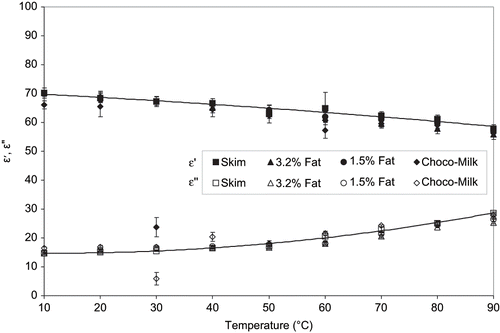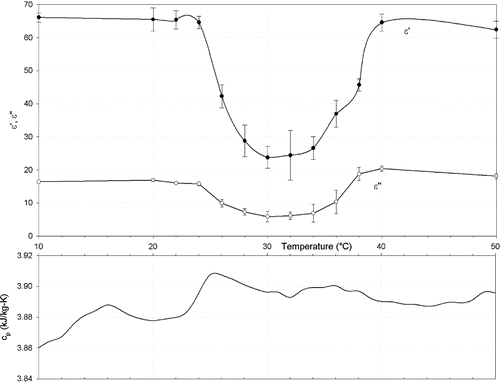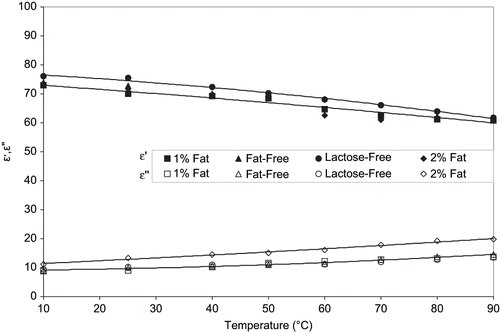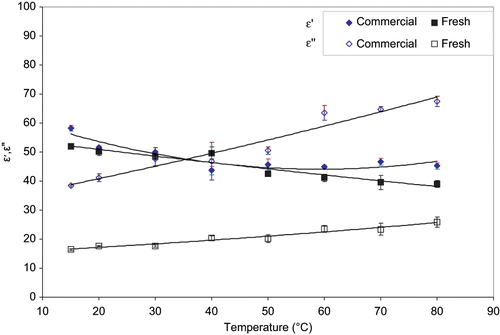Abstract
Dielectric properties of pumpable food materials having a potential to be processed using a continuous flow microwave heating system were measured at 915 MHz and in the temperature range of 10–90°C. The products considered in this study were milk and dairy products (ε′: 70.0 to 50.8 and ε″: 14.7 to 41.3), ready to eat puddings (ε′: 69.4 to 52.1 and ε″: 17.2 to 23.8), soy beverages (ε′: 75.4 to 60.8 and ε″: 9.0 to 19.8), and avocado products (ε′: 51.6 to 39.0 and ε″: 17.7 to 67.5). The results showed that the dielectric constant decreased with an increase in temperature and the dielectric loss factor increased with an increase in temperature. Polynomial correlations for the dependence of dielectric properties on temperature were developed. The dielectric properties measured in this study are important parameters for designing a continuous flow microwave heating system for processing pumpable food materials.
INTRODUCTION
Continuous flow microwave heating is one of the emerging technologies in the field of food processing with a potential to replace the conventional heating system for viscous and particulate food products. In the U.S., only four microwave frequencies (915 ± 13, 2450 ± 50, 5800 ± 75, and 24,150 ± 125 MHz) are permitted by the Federal Communications Commission (FCC) for industrial, scientific, and medical applications. Household microwave ovens operate at 2450 MHz whereas most of the industrial microwave systems in the U.S. operate at 915 MHz due to the higher penetration depth at 915 MHz.[Citation1] A continuous flow microwave heating system operating at 915 MHz is desired because a higher penetration depth allows the use of larger tube diameters. Research on tubular continuous flow microwave heating systems has been carried out showing promise for thermal treatment of liquid and pumpable foods.[Citation2]
The extent of heating by microwaves is determined by the wavelength of the microwaves and dielectric properties of the food materials. Dielectric properties are the complex representation of the relative permittivity of a material as follows:
Power penetration depth (Dp), often used in microwave heating applications, is the distance at which the power drops to e−1 of its value at the surface of the material and is given by the following equation[Citation1]:
Dielectric properties can be measured using several methods, with the open-ended coaxial probe method being the preferred technique for liquids and liquid-like materials.[Citation5] Dielectric properties of food materials are dependent on the frequency of the microwaves, temperature, composition, and density of the food materials. Variation of dielectric properties with temperature is a result of changes the product undergoes with temperature, such as increased mobility of the ions, changes in structure due to melting of fat, formation and break-down of gels, and denaturation of protein.[Citation1] It is very important to understand and predict this temperature dependency for designing a continuous flow microwave heating system to be used in food processing as changes in dielectric properties will change the absorption of microwaves, and thus the heating rate of the product, as well as the uniformity of temperature distribution.
Dielectric properties have received a lot of attention over the last 20 years, coinciding with the increase in use of microwave ovens at home. Many studies have been done to determine the dielectric properties of food materials.[Citation1,Citation4,Citation6,Citation7,Citation8,Citation9] However, little data is available for industrial applications using a frequency of 915 MHz for pumpable food materials, despite increased interest in the use of continuous flow tubular microwave heating systems. Thus, the current study was undertaken to measure the dielectric properties of selected pumpable food products at 915 MHz and in the temperature range of 10–90°C. The food products were chosen based on their potential compatibility with a continuous flow microwave heating system.
MATERIALS AND METHODS
A list of the products tested in this study is presented in . These products were chosen based on the possible use of continuous flow microwave heating systems for their processing. The products were purchased from a local supermarket, and were considered representative of the category of foods being analyzed. Moisture content and pH of the products were measured using a moisture analyzer (SMART Trac System5, CEM Corp., Mathews, NC) and pH tester (XL 15, Thermo Fisher Scientific, Waltham, MA), respectively.
Table 1 Moisture content (%) and pH of the products tested in this study
Samples were homogenized (when needed) using a blender and heated in a water bath to attain the testing temperatures (which was between 10–90°C). The samples were taken out of the water bath and placed inside an insulation block while performing the experiments to measure the dielectric properties. After the dielectric properties were measured, the temperature of the samples was measured again to ensure that it was within 2°C of the desired temperature. Three measurements per sample and three repetitions were performed.
Dielectric properties of the samples were measured from 20 to 90°C using an open-ended coaxial probe (HP 85070B, Agilent Technologies, Palo Alto, CA) connected to a network analyzer (HP 8753C, Agilent Technologies, Palo Alto, CA). The network analyzer was calibrated by leaving the tip of the probe in contact with air, metal, and 25°C de-ionized water and measuring the dielectric properties. A warm-up time of 3 hours was allowed before measurements were performed. The dielectric properties were measured at 300 frequencies (equally spaced) in the range of 850 to 1,050 MHz.
To verify the calibration of the instrument at different temperatures, the dielectric properties of distilled water were measured and the results were compared to the predictive equation.[Citation6] The error between the experimental and the published data was 1% at 20°C and 3.7% at 90°C.
Dielectric properties of chocolate milk showed a deviation from those of skim milk and 3.2% fat milk. To better understand this deviation, the specific heat (cp) of chocolate milk was measured using a differential scanning calorimeter (DSC7, Perkin Elmer Instruments, Norwalk, CT). Sixty μL of the product was pipetted into large volume stainless steel pans. Samples were scanned from 2–105°C with isothermal steps at a heating rate of 2.5°C/min. The 2-curve method built-in the manufacturer's Pyris software (version 3.1) was used to calculate the specific heat of the samples.
RESULTS AND DISCUSSION
Moisture content and pH of the food products are presented in . The dielectric properties of the food products at 915 MHz measured using the network analyzer were collected and analyzed. The average values are presented in . Correlations of the dielectric properties of the products tested in this study as a function of temperature were developed and are tabulated in Second order polynomial correlations were developed using Sigmaplot (SSPS Inc., Chicago, IL).
Figure 1 Dielectric constant (ε′) and dielectric loss factor (ε″) of milk and dairy products at 915 MHz.

Figure 2 Dielectric constant (ε′), dielectric loss factor (ε″), and specific heat of chocolate milk.

Table 2 Correlations for dielectric properties as a function of temperature at 915 MHz
Values of dielectric constant for all the products were lower than those of water (83.6 at 10°C and 67 at 90°C), and the values of dielectric loss factor were higher than those of water (5.7 at 10°C and 0.85 at 90°C), calculated using the predictive equation developed by Kaatze.[Citation10] In addition, a decrease in dielectric constant and an increase in dielectric loss factor with temperature were observed for all the products. These observations were similar to previous published data at various frequencies.[Citation6,Citation11,Citation12]
Milk and Dairy Products
The dielectric properties of milk and dairy products at 915 MHz are shown in . The dielectric properties of skim milk and 3.2% fat milk are very similar, with differences of less than 2% over the whole range of temperatures. This observation is consistent with the finding that the fat content has negligible effect on the dielectric properties of milk.[Citation13] The value of the dielectric constant ranged from 70 to 57.7 and those of the dielectric loss factor from 14 to 28 for a temperature range of 10 to 90°C.
The results obtained in this study were consistent with the results obtained in another study in which dielectric properties of milk were measured at 1 GHz.[Citation14] In that study, milk was prepared using its constituents and the results were compared to a 0.1M solution of NaCl using the Hasted-Debye equations. The values of the dielectric constant at 1 GHz were similar to the ones measured in this study. However, the values of the loss factor were noticeable larger than the ones measured in this study. This can be attributed either to the use of constituents to prepare milk compared to the use of real milk, or to the use of a standing wave method as compared to the conductivity method. used in that study.[Citation14]
Chocolate flavored milk (1.5% fat) was unique in the way that it presented a deviation from the behavior of skim and 3.2% fat milk, as shown in . A decrease in dielectric properties was observed at 30°C with the values of ε′ changing from 65 to 23 and the values of ε′′ changing from 16 to 5 as the temperature increased from 20 to 30°C. Since this decrease appeared in all replicates of the experiment, an experiment was conducted in order to better understand the phenomenon observed. The temperature was slowly increased from 20–40°C in intervals of 2°C in that experiment. It was observed that the dielectric properties followed the same trend as that of skim milk in the 20–24°C range, but from that temperature onwards, both ε′ and ε′′ decreased. The minimum value of ε′ and ε′′, observed at 30°C, was 23.75 and 5.84, respectively. The values of ε′ and ε′′ were observed to follow the trend found for skim milk from 40°C onwards. The specific heat of chocolate milk was measured to observe if any phase changes occurred in this temperature range, which could affect the dielectric properties of the product. The specific heat data obtained using DSC is shown in . It was observed that a maxima of specific heat existed at 25°C which coincides with the start of the decrease in dielectric properties. Since the change in specific heat is not a discontinuity and the value changes only slightly, a secondary change of phase in the product is most likely taking place. This can be attributed to changes in the gel structure of the stabilizer used to maintain the suspension of chocolate milk.
Soy Beverages
The dielectric properties of soy beverages at 915 MHz are shown in . These followed the same general trend observed with dairy products, i.e., a decrease in the value of ε' and an increase in the value of ε” with an increase in temperature. Values of dielectric constant for the beverages tested were similar to those of milk, but the values of dielectric loss factor were lower than those of skim milk. The lower loss factor may be a result of the different amounts and nature of solutes found in soy beverages as compared to those found in skim milk.
The dielectric properties of these products were very similar to one another in the range tested with values of ε′ ranging from 73 to 61 and values of ε′′ ranging from 9 to 14 as temperature increased from 10 to 90 °C. However, the 2% fat soy beverage exhibited a different behavior than the rest of the products in this group. The value of the loss factor (11.2 at 10°C and 20 at 90°C) for 2% fat soy beverage was higher than those of the rest of soy beverages. This could be attributed to the presence of emulsifiers in this beverage to keep the increased amount of fat in solution.
Puddings
Dielectric properties of puddings are shown in . It was observed that all the puddings followed the same general trend of decreasing dielectric constant and increasing dielectric loss factor with increasing temperature. The values of the dielectric constant were 64 and 52 at 10 and 90°C, respectively. However, the increase in the value of loss factor with temperature was relatively smaller than the one observed for milk. The values of ε′′ at 10 and 90°C were 17.2 and 22.7, respectively, which is an increase of 32%. This can be attributed to the lack of mobility of the ions in the starch matrix as opposed to that in a liquid matrix.
Both cornstarch and tapioca puddings had dielectric properties similar to one another, while the fat-free pudding had a higher dielectric constant and higher loss factor than the other products of this group. Differences in dielectric properties between fat-free pudding and the other types of pudding tested could be a result of the different starch matrix,[Citation15] or a result of the added water and salts as fat replacers in a similar manner to the results of a previous study.[Citation16]
Avocado Products
Dielectric properties of avocado paste products are shown in . The values of the dielectric constant of fresh-made avocado paste ranged from 51 to 39 and the values of the dielectric loss factor ranged from 16 to 26 as temperature increased from 15 to 85°C. The values are similar to the values of fresh avocado measured in a previous study at 23°C.[Citation14] Values of the dielectric constant of both products followed a similar trend, with the values of the dielectric constant of fresh avocado being lower than those of the commercial avocado paste at 70 and 80°C. The loss factor of the commercial avocado paste was much higher than that of the fresh-made avocado paste and increased rapidly with temperature. This might be a result of the addition of one or more components to the avocado paste to improve flavor or color stability or to prevent the separation of the fat, which increased the ionic mobility and thus the loss factor.
Power Penetration Depth
Power penetration depth (Dp) of microwaves in a semi-infinite slab was calculated for representative products for each of the categories of foods used in this study by using EquationEq. (3). The results of penetration depth calculations are shown in as a function of temperature for the representative products of each category. From , it can be seen that the penetration depth decreased with an increase in temperature. It can also be observed that the products with a higher loss factor have a smaller value of Dp.
Figure 6 Penetration depth as a function of temperature for representative products from each category.

While these penetration depths were calculated for semi-infinite slabs, it can be inferred that a similar phenomena would occur with cylindrical tubes. The maximum diameter of the applicator tube that could be used is directly related to the penetration depth in a slab. Thus, the maximum diameter of the tubes at colder temperatures could be larger than that at higher temperatures because products have higher loss factor at colder temperatures. A large maximum diameter should be indicative of the need to use higher frequencies, while a small maximum diameter should be indicative of the need to use lower frequencies to increase the penetration depth and optimize the conversion of microwave energy into heat.
CONCLUSIONS
The dielectric properties of milk and dairy products, soy beverages, puddings, and avocado products measured in this study serve as a step towards developing a comprehensive database of these properties at 915 MHz. The results showed that the dielectric properties of the selected food products followed a trend of decreasing dielectric constant and increasing loss factor with an increase in temperature. A decrease in the dielectric properties of chocolate milk was observed at 30°C which was a deviation from the behavior of other dairy products. The decrease was attributed to changes in the gels used as stabilizers by comparing the decrease in the values of dielectric properties to specific heat data obtained using a DSC. The results from this study will be very useful in designing a continuous flow microwave heating system to process the products analyzed.
ACKNOWLEDGMENTS
Support for the research study undertaken here, resulting in the publication of Paper No. FSR-03-21 of the Journal Series of the Dept. of Food Science, NCSU, Raleigh, NC 27695-7624, from Industrial Microwave Systems and Center for Advanced Processing and Packaging Studies (CAPPS) is gratefully acknowledged. We would also like to thank Joanna Foegeding for her help in conducting the pH measurements.
The use of trade names in this publication does not imply endorsement by the North Carolina Agricultural Research Service of the products named nor criticism of similar ones not mentioned.
REFERENCES
- Nelson , S.O. and Datta , A.K. 2001 . “ Dielectric properties of food materials and electric field interactions ” . In Handbook of microwave technology for food applications , Edited by: Datta , A.K. and Anantheswaran , R.C. 69 – 114 . New York, NY : Marcel Dekker, Inc. .
- Coronel , P. , Simunovic , J. and Sandeep , K.P. 2003 . Temperature profiles within milk after heating in a continuous-flow tubular microwave system operating at 915 MHz . Journal of Food Science , 68 ( 6 ) : 1976 – 1981 .
- Metaxas , A.C. and Meredith , R.J. 1983 . Industrial microwave heating , 26 – 69 . London, , U.K. : Peter Peregrinus, Ltd .
- Nelson , S.O. 1999 . Dielectric properties of agricultural products . IEEE Transactions on Electrical Insulation , 26 ( 5 ) : 845 – 869 .
- Boughriet , A. , Wu , Z. , McCann , H. and Davis , L.E. 2003 . The measurement of dielectric properties of liquids at microwave frequencies using open-ended coaxial probes . Trans. 1st World Congress on Industrial Process Tomography , 318–322
- Kent , M. 1987 . Electrical and dielectric properties of food materials: a bibliography and tabulated data , London, , U.K. : Science and Technology Publishers .
- Nelson , S.O. , Forbus , W.R. and Lawrence , K.C. 1994 . Microwave permittivities of fresh fruits and vegetables from 0.2 to 20 GHz . Transactions of the ASAE , 37 ( 1 ) : 183 – 189 .
- Regier , M. , Housova , J. and Hoke , K. 2001 . Dielectric properties of mashed potatoes . International Journal of Food Properties , 4 ( 3 ) : 431 – 439 .
- Sipahioglu , O. and Barringer , S.A. 2003 . Dielectric properties of vegetables and fruits as a function of temperature, ash, and moisture content . Journal of Food Science , 68 ( 1 ) : 234 – 239 .
- Kaatze , U. 1989 . Complex Permittivity of Water as a Function of Frequency and Temperature . Journal of Chemical Engineering Data , 34 : 371 – 374 .
- Hasted , J.B. 1973 . Aqueous dielectrics , New York : John Wiley & Sons .
- Fasina , O.O. , Farkas , B.E. and Fleming , H.P. 2003 . Thermal and dielectric properties of sweetpotato puree . International Journal of Food Properties , 6 ( 3 ) : 461 – 472 .
- Kudra , T. , Van de Voort , F.R. , Raghavan , G.S.V. and Ramaswamy , H.S. 1991 . Heating characteristics of milk constituents in a microwave pasteurization system . Journal of Food Science , 56 ( 4 ) : 931 – 937 .
- Mudgett , R.E. , Smith , A.C. , Wang , D.I.C. and Goldblith , S.A. 1974 . Prediction of dielectric properties in nonfat milk at frequencies of interest in microwave processing . Journal of Food Science , 39 ( 1 ) : 52 – 54 .
- Ndife , M.K. , Sumnu , G. and Bayindirli , L. 1998 . Dielectric properties of six different species of starch at 2450 MHz . Food Research International , 31 ( 1 ) : 43 – 52 .
- Rozzi , N.L. and Singh , R.K. 2000 . The effect of selected salts on the microwave heating of starch solutions . Journal of Food Processing and Preservation , 24 : 265 – 273 .


